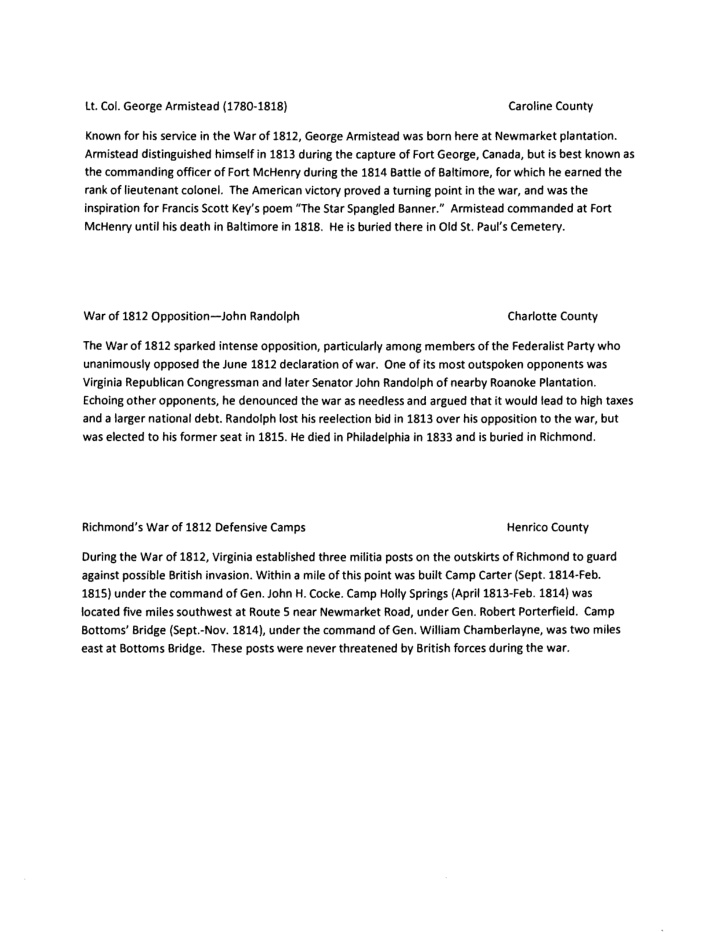



It. Col. George Armistead (1780-1818) Caroline County Known for his service in the War of 1812, George Armistead was born here at Newmarket plantation. Armistead distinguished himself in 1813 during the capture of Fort George, Canada, but is best known as the commanding officer of Fort McHenry during the 1814 Battle of Baltimore, for which he earned the rank of lieutenant colonel. The American victory proved a turning point in the war, and was the inspiration for Francis Scott Key's poem "The Star Spangled Banner." Armistead commanded at Fort McHenry until his death in Baltimore in 1818. He is buried there in Old St. Paul's Cemetery. War of 1812 Opposition-John Randolph Charlotte County The War of 1812 sparked intense opposition, particularly among members of the Federalist Party who unanimously opposed the June 1812 declaration of war. One of its most outspoken opponents was Virginia Republican Congressman and later Senator John Randolph of nearby Roanoke Plantation. Echoing other opponents, he denounced the war as needless and argued that it would lead to high taxes and a larger national debt. Randolph lost his reelection bid in 1813 over his oppOSition to the war, but was elected to his former seat in 1815. He died in Philadelphia in 1833 and is buried in Richmond. Richmond's War of 1812 Defensive Camps Henrico County During the War of 1812, Virginia established three militia posts on the outskirts of Richmond to guard against possible British invasion. Within a mile of this point was built Camp Carter (Sept. 1814-Feb. 1815) under the command of Gen. John H. Cocke. Camp Holly Springs (April 1813-Feb. 1814) was located five miles southwest at Route 5 near Newmarket Road, under Gen. Robert Porterfield. Camp Bottoms' Bridge (Sept.-Nov. 1814), under the command of Gen. William Chamberlayne, was two miles east at Bottoms Bridge. These posts were never threatened by British forces during the war.
War of 1812 markers in need of sponsors President-Little Belt Affair Virginia Beach British impressment of United States sailors into military service prompted the 44-gun frigate USF President, commanded by Comm. J. Rodgers, to cruise along the coast in this area watching for British warships. The President encountered the 20-gun HMS little Belt off the Chesapeake Capes on 16 May 1811. When the British sloop did not identify its purpose, the two ships began exchanging broadsides. The Little Belt was badly damaged and the engagement ended. This naval duel provoked disagreement about freedom of the seas and impressment that resulted in the U.S. declaration of war in June 1812. British Naval Blockade and Cape Henry Lighthouse Virginia Beach During the War of 1812, a British naval blockade along much of the U.S. East Coast disrupted foreign trade and interfered with commerce. On 4 Feb. 1813, the blockade was extended to the Chesapeake Bay. At that time, the light at the Cape Henry lighthouse was extinguished to prevent British ships from using it as a navigational aid. The British attacked the lighthouse early in Feb. 1813 and thereafter British scouting parties often visited the area to obtain freshwater from local wells. On 14 July 1813, Captain lawson of the Princess Anne militia captured 20 British marines nearby. War of 1812 Elizabeth River Defenses Norfolk President George Washington authorized the construction of 19 coastal defense fortifications in 1794. Nearby Fort Norfolk, which mounted 37 guns, and Fort Nelson, armed with 10 cannon, were constructed by 1810 to guard the Elizabeth River approaches to Norfolk, Portsmouth, and Gosport Navy Yard. Additional defensive works, Forts Barbour and Tar, were later added and a blockhouse was built on Craney Island. Because Craney Island was successfully defended against the British on 22 June 1813, Forts Norfolk and Nelson never fired their guns during the war. Only Fort Norfolk survived as a relic of this conflict. (over)
War of 1812 Markers: Status as of 19 May 2014 Erected Since May 2013 British Approach to Hampton (7/9/2013) Hampton Sack of Hampton (7/912013) Hampton War of 1812 Legacy (7/9/2013) Hampton British Landing at Nomini Ferry (7/20/2013) Westmoreland County Capture of the Dolphin (12/03/2013) Lancaster County Previously Erected African Americans in the War of 1812 Northumberland County Northumberland County British Attacks on Kinsale and Mundy Point Dolley Madison (1768-1849) Orange County Manufactured; Dedication Upcoming Admiral Sir George Cockburn on the Chesapeake (06/25/14) Hampton Not Yet Manufactured; Awaiting Dedication Scheduling Sponsors Have Been Identified Governor James Barbour Orange County Dinwiddie County Winfield Scott (1786-1866) Capture of Tappahannock* Essex County Sponsors Not Yet Identified President-Little Belt Affair Virginia Beach British Naval Blockade and Cape Henry Lighthouse Virginia Beach War of 1812 Elizabeth River Defenses Norfolk Lt. Col. George Armistead (1780-1818) Caroline County Charlotte County War of 1812 Opposition-John Randolph Henrico County Richmond's War of 1812 Defensive Camps *revisions to text of marker proposed by Essex County Museum
Recommend
More recommend